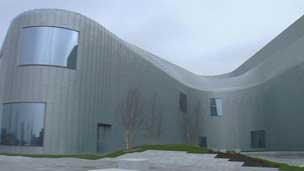Excitement builds ahead of river museum's opening
- Published
The new Riverside Museum, which houses Glasgow's transport collection, is to open to the public later this month.
For the last two years, the silver curves of Glasgow's new Riverside Museum have been a familiar sight to passers-by on either side of the River Clyde.
The sweep of the silver curves on the roof, designed by the architect Zaha Hadid, to reflect the river it sits alongside. Indeed when the museum officially opens, visitors will be able to arrive by boat, from the opposite side of the river at Govan.
But while the exterior has become as familiar a landmark as the neighbouring Armadillo, the interior has been a closely guarded secret. Until now.
Today, three weeks ahead of its public opening, photographers, journalists and TV crews were given the chance to look inside.

The Riverside is the first major museum to open in Glasgow since The Burrell Collection in 1983
Although it is my first time, with a camera crew in tow and a radio recorder in hand, I've had a couple of tours as the building has taken shape, and know exactly what to expect.
The fluorescent green colour scheme is probably the biggest surprise. It may lift the grey steel but it is likely to divide opinion.
One of the first exhibits, a winding road alongside the curve of the entrance hall, is likely to become a firm favourite.
A selection of vehicles telling the story of the road tests carried out on the twists and turns of the Rest and Be Thankful by various car manufacturers.
Glasgow street
Behind that, the museum's flagship exhibit - a Glasgow street at the end of the late 1890s.
Main Street is based on the much loved Kelvin Street - from the old Transport Museum but it has been expanded, not least by allowing visitors to step inside the shops (except the dress shop, which true to the original, remains exclusive to only a handful of wealthy Glaswegians).
Many of the shops are real businesses, reclaimed after closure.

The Riverside Museum is designed by Stirling Prize-winner Zaha Hadid
The Rendezvous café may be familiar to anyone from the city's Duke Street area. Opened in the 1920s by Giovanni Tognieri, his grandchildren Alma Reid and Giacomo Turri both worked there, and this week will return to see how the café looks in its new museum setting.
The Mitre Bar has also been removed - lock stock and barrel - from its location in the Merchant City.
There is also other recognisable businesses of the era - from a cobblers, to a pawnbrokers and a photography studio.
Not to mention a saddlers - big business for the then Glasgow Corporation, which had up to 3,000 horses to care for.
Part of the reason the old museum had to close so long before this place opened, is that a subway train and station had to be installed in the foundations of the new building.
That meant curators having to dismantle the first street.
'Quiet spaces'
As well as Main Street, there are two more avenues which explore Glasgow's history between the 30s and the 60s and between the 1960s and the 1980s, with vehicles and shop fronts getting more and more modern the further up the street you walk.
Opinions will be divided about the "car wall" where up to 40 vehicles can be viewed from above and below.
Vehicles can be swapped over on hydraulic platforms - and while it will thrill many younger visitors, it is bound to dismay those who simply want to walk round an old favourite.
Pride of place goes to the South African Railways locomotive, made in Polmadie in 1945, and left to rust in a sidings in South Africa in the 1980s.
Saved from the scrap heap, and lovingly restored, it is now one of the most impressive exhibits on show.
There are "quiet spaces" around the museum too, one of which will be devoted to the ongoing story of Lockerbie.
The Tall Ship Glenlee is now moored outside, and will hopefully get a welcome boost in visitor numbers from its new berth.
The setting is crucial to it all.
Those ships in glass cases, so lost in the upstairs rooms of the old museum, make perfect sense when viewed alongside the river, which would once have resounded to the sounds of scores of shipyards.
The museum will open to the public on 21 June.
- Published21 March 2011
- Published21 December 2010
- Published12 November 2010
- Published20 September 2010